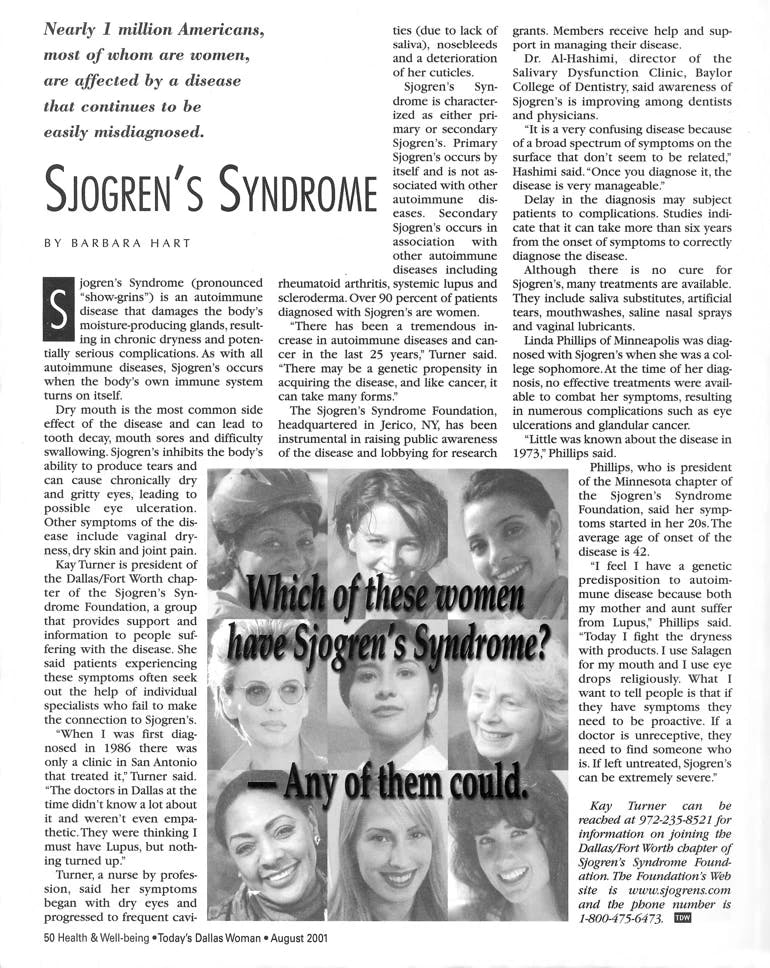Sjogren’s Syndrome
Sjogren's Syndrome (pronounced "show-grins") is an autoimmune disease that damages the body's moisture-producing glands, resulting in chronic dryness and potentially serious complications. As with all autoimmune diseases, Sjogren's occurs when the body's own immune system turns on itself.
Dry mouth is the most common side effect of the disease and can lead to tooth decay, mouth sores and difficulty swallowing. Sjogren's inhibits the body's ability to produce tears and can cause chronically dry and gritty eyes, leading to possible eye ulceration. Other symptoms of the disease include vaginal dryness, dry skin and joint pain.
Kay Turner is president of the Dallas/Fort Worth chapter of the Sjogren's Syndrome Foundation, a group that provides support and information to people suffering with the disease. She said patients experiencing these symptoms often seek out the help of individual specialists who fail to make the connection to Sjogren's.
“When I was first diagnosed in 1986 there was only a clinic in San Antonio that treated it," Turner said. "The doctors in Dallas at the time didn't know a lot about it and weren't even empathetic. They were thinking I must have Lupus, but nothing turned up."
Turner, a nurse by profession, said her symptoms began with dry eyes and progressed to frequent cavities (due to lack of saliva), nosebleeds and a deterioration of her cuticles.
Sjogren's Syndrome is characterized as either primary or secondary Sjogren's. Primary Sjogren's occurs by itself and is not associated with other autoimmune diseases. Secondary Sjogren's occurs in association with other autoimmune diseases including rheumatoid arthritis, systemic lupus and scleroderma. Over 90 percent of patients diagnosed with Sjogren's are women.
"There has been a tremendous increase in autoimmune diseases and cancer in the last 25 years,” Turner said. “There may be a genetic propensity in acquiring the disease, and like cancer, it can take many forms.”
The Sjogren's Syndrome Foundation, headquartered in Jerico, NY, has been instrumental in raising public awareness of the disease and lobbying for research grants. Members receive help and support in managing their disease.
Dr. Al-Hashimi, director of the Salivary Dysfunction Clinic, Baylor College of Dentistry, said awareness of Sjogren's is improving among dentists and physicians.
"It is a very confusing disease because of a broad spectrum of symptoms on the surface that don't seem to be related,” Hashimi said. "Once you diagnose it, the disease is very manageable."
Delay in the diagnosis may subject patients to complications. Studies indicate that it can take more than six years from the onset of symptoms to correctly diagnose the disease.
Although there is no cure for Sjogren's, many treatments are available. They include saliva substitutes, artificial tears, mouthwashes, saline nasal sprays and vaginal lubricants.
Linda Phillips of Minneapolis was diagnosed with Sjogren's when she was a college sophomore. At the time of her diagnosis, no effective treatments were available to combat her symptoms, resulting in numerous complications such as eye ulcerations and glandular cancer.
"Little was known about the disease in 1973,” Phillips said.
Phillips, who is president of the Minnesota chapter of the Sjogren's Syndrome Foundation, said her symptoms started in her 20s. The average age of onset of the disease is 42.
"I feel I have a genetic predisposition to autoimmune disease because both my mother and aunt suffer from Lupus,” Phillips said. “Today I fight the dryness with products. I use Salagen for my mouth and I use eye drops religiously. What I want to tell people is that if they have symptoms they need to be proactive. If a doctor is unreceptive, they need to find someone who is. If left untreated, Sjogren's can be extremely severe."


